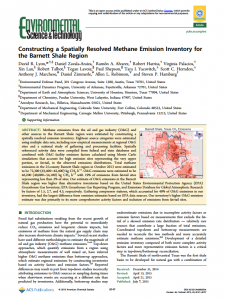Full Title: Constructing a Spatially Resolved Methane Emission Inventory for the Barnett Shale Region
Author(s): David R. Lyon, Daniel Zavala-Araiza, Ramon A. Alvarez, ́Robert Harriss, Virginia Palacios, Xin Lan, Robert Talbot, Tegan Lavoie, Paul Shepson, Tara I. Yacovitch, Scott C. Herndon, Anthony J. Marchese, Daniel Zimmerle, Allen L. Robinson, and Steven P. Hamburg
Publisher(s): ACS Publications
Publication Date: July 1, 2015
Full Text: Download Resource
Description (excerpt):
Methane emissions from the oil and gas industry (O&G) and other sources in the Barnett Shale region were estimated by constructing a spatially resolved emission inventory. Eighteen source categories were estimated using multiple data sets, including new empirical measurements at regional O&G sites and a national study of gathering and processing facilities. Spatially referenced activity data were compiled from federal and state databases and combined with O&G facility emission factors calculated using Monte Carlo simulations that account for high emission sites representing the very upper portion, or fat-tail, in the observed emissions distributions. Total methane emissions in the 25-county Barnett Shale region in October 2013 were estimated to be 72,300 (63,400−82,400) kg CH4 h−1 . O&G emissions were estimated to be 46,200 (40,000−54,100) kg CH4 h−1 with 19% of emissions from fat-tail sites representing less than 2% of sites. Our estimate of O&G emissions in the Barnett Shale region was higher than alternative inventories based on the United States Environmental Protection Agency (EPA) Greenhouse Gas Inventory, EPA Greenhouse Gas Reporting Program, and Emissions Database for Global Atmospheric Research by factors of 1.5, 2.7, and 4.3, respectively. Gathering compressor stations, which accounted for 40% of O&G emissions in our inventory, had the largest difference from emission estimates based on EPA data sources. Our inventory’s higher O&G emission estimate was due primarily to its more comprehensive activity factors and inclusion of emissions from fat-tail sites.
